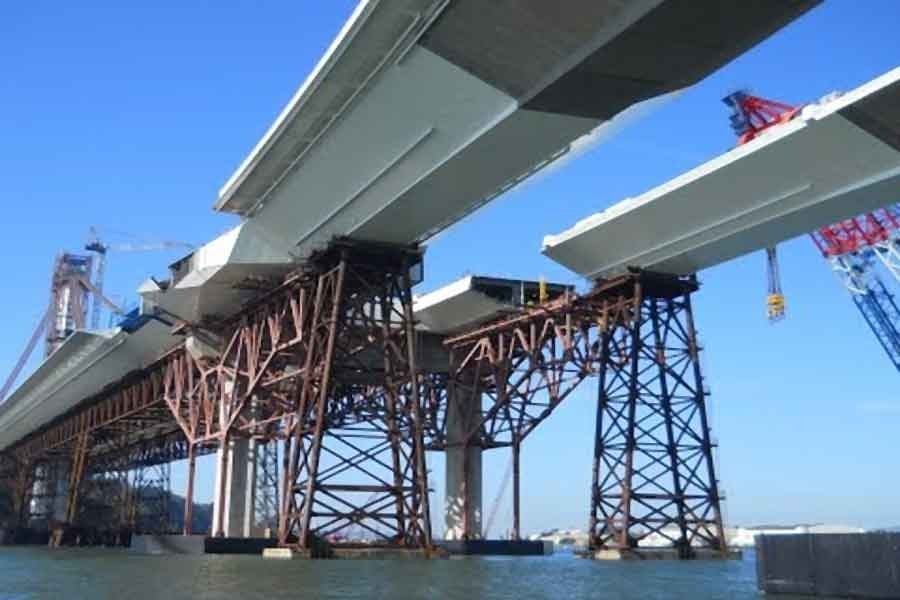Padma Bridge: Economic benefits and policy focus

Fabiha Bushra Khan and Jabun Naher
Published :
Updated :

Construction of the Padma Bridge is expected to be completed by 2022 making it the 122nd longest bridge in the world and the longest in Bangladesh. This marvellous infrastructure is set to unfurl great potential especially for the marginalised people of the south-western parts in Bangladesh. It will contribute substantially to the Gross Domestic Product (GDP) of Bangladesh through creation of strong supply chains that will enhance investment, external and internal trade, employment generation, poverty alleviation and eventually improve socio-economic status of the population.
It is expected that the bridge will contribute to nearly 2.0 per cent of GDP in the country's economy. According to conventional economic analysis, the accumulative effects on GDP could be traced as follows. Ease of transportation will create new business opportunities for the agricultural and industrial sectors. This will generate a new investment hub for both local and foreign investors which in turn will lead to establishment of new industrial units, resulting in numerous employment opportunities. As demand for labour increases, there will be more recruitment, re-skilling or up-skilling of the labour force according to industrial needs and a possible rise in the minimum wages. Wider economic opportunities, therefore will eventually alleviate poverty, raise living standards and produce inter-generational gains on greater affordability of higher level of education and necessary healthcare.
Given that the agricultural sector is still a vital contributor to GDP, the aforementioned economic gains would be substantial in case of considerable proportions of investment mobilised in favour of agriculture. The Padma Bridge will create this invaluable opportunity wherein enhanced connectivity across the country coupled with strong supply chains will enable agricultural produce to be transported to different parts of the country within a reasonable time period. Farmers will benefit from being able to maintain quality of their perishable commodities as well as lower production costs due to transportation and storage facilities. Furthermore, direct communication with large dealers of agricultural commodities will also ensure fair prices for farmers. A combination of all this in turn will provide a unique potential for economic engagement of the youth force which could be incentivised to seek employment or create enterprises in the agricultural sector.
Youth engagement in social, economic and civic activities is a fundamental mechanism to address the much debated concept of demographic dividend. An increased scope for industrialisation will likely raise the number of educational institutions in the region along with creation of greater economic opportunities. Thus, human capital development will be enhanced, proportion of NEET (Not in Education, Employment or Training) youths will decrease as they integrate with the formal employment network and enthusiastic young entrepreneurs could do excel particularly in small and medium-size businesses.
In addition, increased investment and industrial growth in the south-western regions induced by enhanced connectivity will have multiple spill-over effects in the form of network economies benefitting the micro, small and medium-size enterprises (MSMEs). In essence, integration of SMEs with the local production systems will enable them to network with other firms and support institutions and gain from economies of scale in purchase, production and distribution. Therefore, greater access to market and resources will enhance sustainability of MSMEs and allow such businesses to thrive through gains in productivity, profitability and in the process influence decisions at policy levels.
Last but not least, urbanisation pressure on Dhaka is expected to reduce as enterprises developed in the south-western parts will dampen the frequency of the rural-urban migration caused by the various livelihood prospects in Dhaka. Hence, investment and employment opportunities in the south-western part could potentially lead to industrial decentralisation and lower concentration in Dhaka which could be a key instrument to improve quality of life in the capital.
The multitude of economic prospects offered by the Padma Bridge mandates the right set of policies targeted towards the most relevant economic actors. Policymakers will need to design and implement business-facilitating policies that will boost investor confidence and make business environment conducive to foreign direct investment. Such strategic interventions will result in further gains if policy focus promotes inter-firm networks to attain sustainable and inclusive industrial growth. Furthermore, policies can result in multiplier effects if youth development is prioritised through ensuring their employment in formal job settings and encouraging establishment and growth of youth entrepreneurship.
Fabiha Bushra Khan and Jabun Naher are research associate and research assistant respectively at SANEM.
fabiha.bushra.khan@gmail.com


 For all latest news, follow The Financial Express Google News channel.
For all latest news, follow The Financial Express Google News channel.